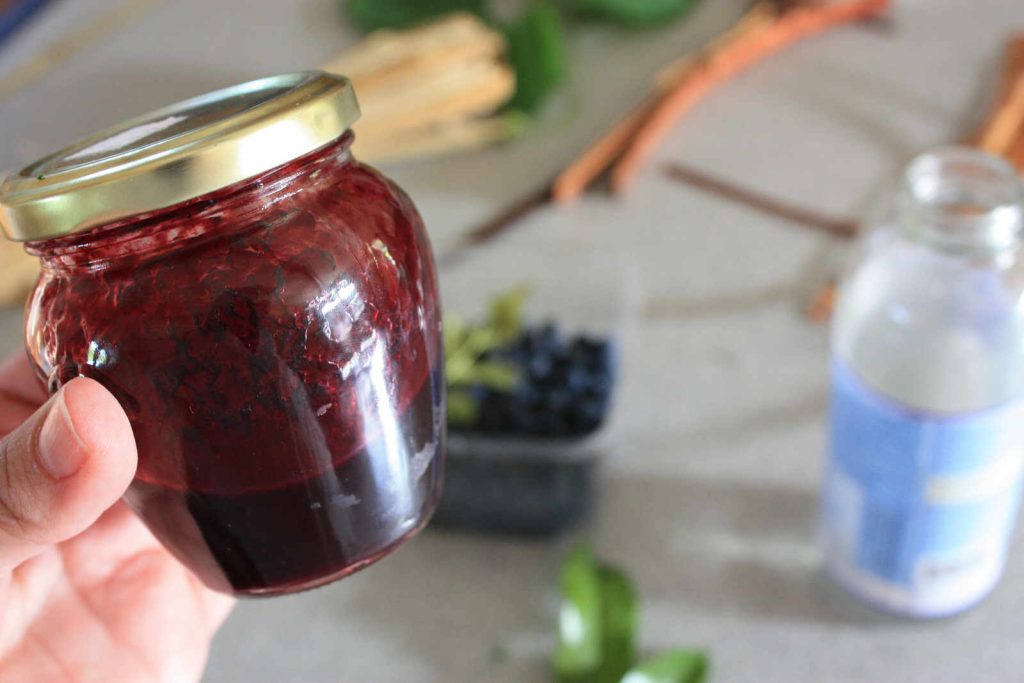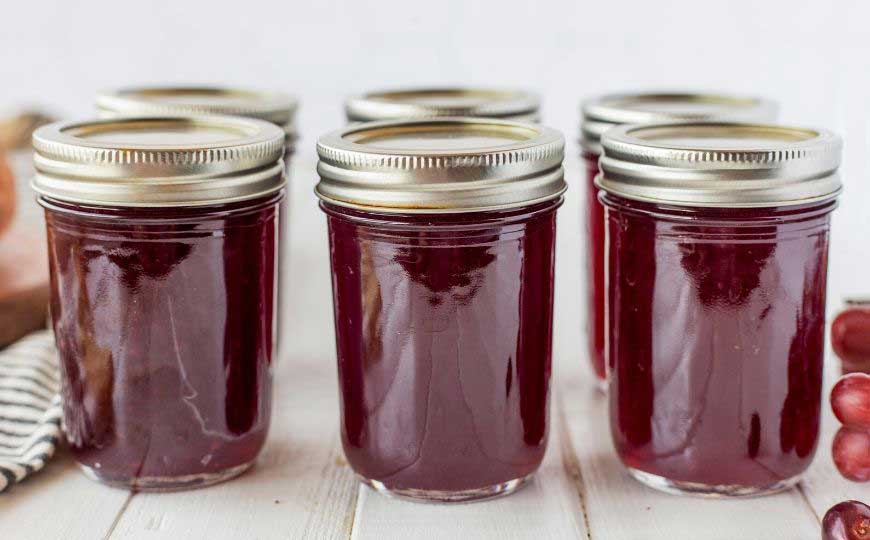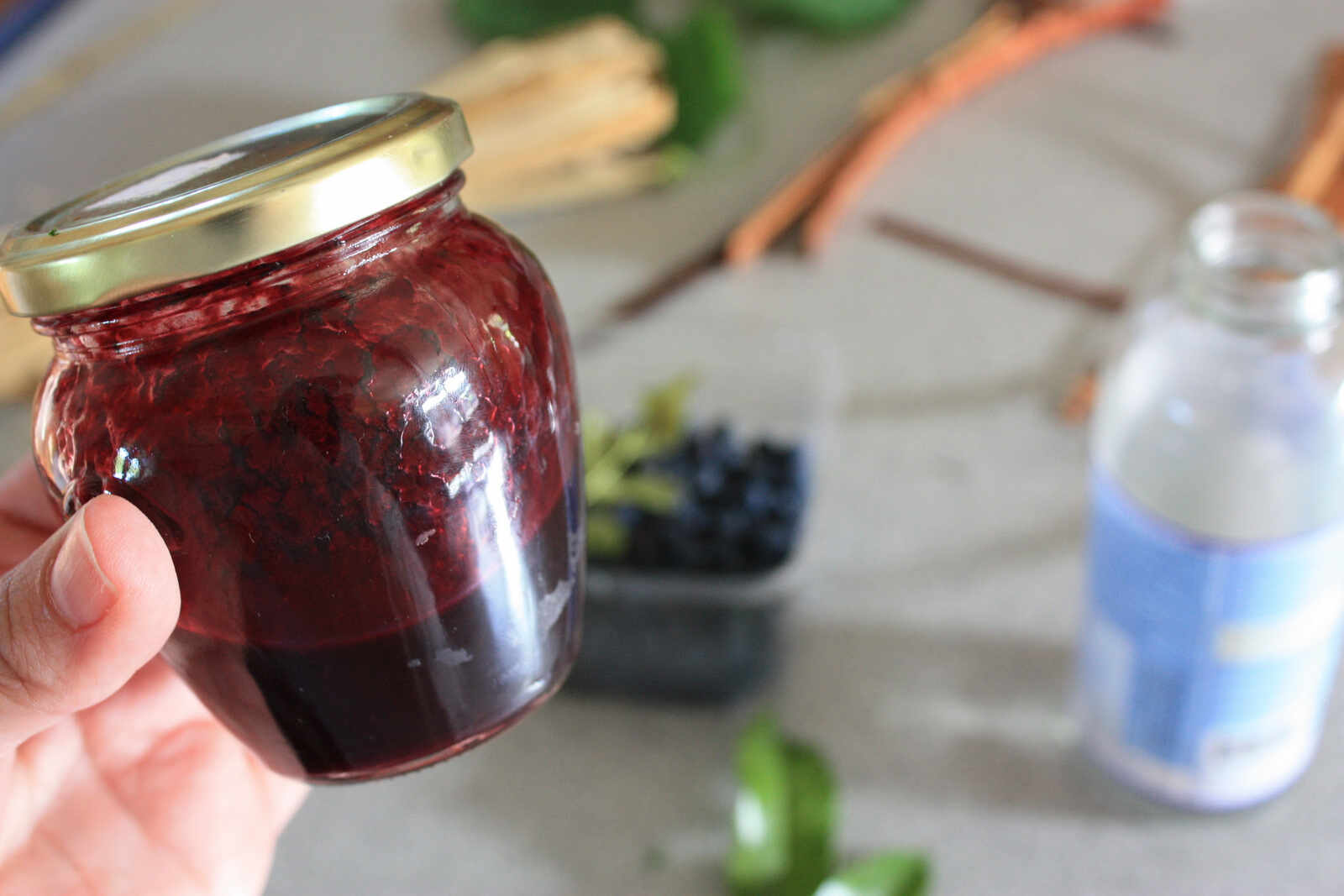Introduction:
How To Make Grape Jelly From Grape Juice Grape jelly is a timeless delight, offering a burst of sweet and tangy flavor that can elevate any breakfast or snack. While the traditional method involves starting from scratch with fresh grapes, there’s a simpler and quicker way to enjoy homemade grape jelly: using grape juice. This method not only saves time but also allows you to capture the essence of fresh grapes in a convenient form. In this guide, we’ll walk you through the easy steps to create your own delicious grape jelly from grape juice, unlocking a world of homemade goodness.

Ingredients:
4 cups of grape juice (preferably without added sugar)
1 package (1.75 oz) of powdered pectin
4 ½ cups of granulated sugar
Lemon juice (optional, for added tartness)
Equipment:
Large pot
Wooden spoon
Canning jars with lids
Water bath canner or large stockpot with a rack
Canning tongs
Ladle
Food thermometer (optional)
Step 1: Prepare Your Equipment
Before diving into the jelly-making process, ensure all your equipment is clean and ready for use. Sterilize your canning jars and lids by either running them through a dishwasher cycle or boiling them in water for a few minutes. Keep them warm until ready to use to prevent cracking when filled with hot jelly.
Step 2: Combine Grape Juice and Pectin
In a large pot, pour the grape juice and whisk in the powdered pectin until it’s fully dissolved. Make sure there are no lumps remaining before proceeding to the next step. If you prefer a slightly tart jelly, add a splash of lemon juice at this stage.
Step 3: Bring to a Boil
Place the pot over medium-high heat and bring the grape juice mixture to a rolling boil, stirring constantly to prevent scorching. Once boiling, continue to stir for another 1-2 minutes to activate the pectin.
Step 4: Add Sugar
Gradually add the granulated sugar to the boiling mixture, stirring continuously until the sugar is completely dissolved. Be patient during this step to ensure the sugar fully integrates with the grape juice mixture.
Step 5: Cook Until Thickened
Allow the mixture to return to a rolling boil and let it cook for about 1-2 minutes longer, stirring constantly. Keep a close eye on the consistency—your jelly should start to thicken and coat the back of a spoon. If you have a food thermometer, the jelly should reach around 220°F (104°C) to ensure proper setting.
Step 6: Perform the Jelly Test
To check if your jelly has reached the desired consistency, perform the “wrinkle test.” Take a small amount of the hot jelly and place it on a chilled plate or spoon. Let it cool for a minute, then push the jelly with your finger. If it wrinkles and holds its shape, it’s ready. If not, continue cooking for a little longer and test again.
Step 7: Fill and Seal Jars
Once your jelly has reached the desired consistency, remove the pot from the heat. Using a ladle, carefully pour the hot jelly into the sterilized jars, leaving about ¼ inch of headspace at the top. Wipe the jar rims clean with a damp cloth to ensure a proper seal, then place the lids on top and screw on the bands until fingertip tight.
Step 8: Process in a Water Bath
Prepare a water bath canner or a large stockpot with a rack. Carefully lower the filled jars into the canner, ensuring they are covered by at least 1 inch of water. Bring the water to a gentle boil and process the jars for 10 minutes (adjusting for altitude if necessary).
Step 9: Cool and Store
Once processed, remove the jars from the water bath using canning tongs and place them on a towel-lined surface to cool completely. As the jars cool, you’ll likely hear the satisfying “pop” of the lids sealing. Allow the jars to sit undisturbed for 12-24 hours to ensure a proper seal.
Conclusion:
How To Make Grape Jelly From Grape Juice Congratulations! You’ve just embarked on a journey to create your own homemade grape jelly using grape juice. With just a few simple ingredients and steps, you’ve unlocked the secret to crafting delicious jelly that rivals any store-bought variety. Whether you spread it on toast, swirl it into yogurt, or dollop it onto pancakes, your homemade grape jelly is sure to be a hit with family and friends. So go ahead, savor the sweet rewards of your culinary prowess, and enjoy every delightful spoonful of your homemade grape jelly.
Homemade Grape Jelly:
Introduction:
In the realm of homemade delights, few things rival the nostalgic charm and delectable taste of homemade grape jelly. With its vibrant color and rich flavor, this culinary creation evokes memories of sunny vineyards and lazy afternoons spent picking grapes. While store-bought options are readily available, there’s something special about crafting your own grape jelly from scratch. Join us on a journey through the art of homemade grape jelly, where simplicity meets sophistication and every jar is a labor of love.
Unveiling the Essence:
At the heart of homemade grape jelly lies the essence of the grape itself. Whether you opt for the bold sweetness of Concord grapes or the subtle elegance of Muscat, the choice of grape sets the tone for your jelly’s flavor profile. For those with access to fresh grapes, the journey begins with hand-picking the ripest bunches, infusing each berry with the warmth of the sun and the richness of the soil. However, for those seeking convenience without sacrificing quality, high-quality grape juice serves as an excellent alternative, capturing the essence of fresh grapes in liquid form. Indulge guilt-free: Waffle Love serves up sweet bliss with just 150 calories per serving!
The Alchemy of Transformation:
Once you’ve secured your grape essence, the alchemy of transformation begins. In a large pot, the grape juice is combined with sugar and a touch of lemon juice, if desired, to balance the sweetness and enhance the tartness. As the mixture heats up, the kitchen fills with the aroma of simmering grapes, a fragrant reminder of the magic unfolding on the stovetop. With each gentle stir of the wooden spoon, the grape juice transforms into a thick, luscious syrup, teeming with flavor and promise.
A Symphony of Flavor:
As the grape syrup reaches its peak, it’s time to unlock the full spectrum of flavor. With the addition of powdered pectin, the syrup thickens into a velvety jelly, ready to be bottled and savored. The final product is a symphony of flavor, with notes of sweetness and tartness dancing across the palate in perfect harmony. Whether spread on warm toast, drizzled over creamy yogurt, or paired with a sharp cheese, homemade grape jelly elevates any culinary creation with its unrivaled taste and texture.
A Labor of Love:
More than just a condiment, homemade grape jelly is a labor of love—a testament to the artistry and dedication of the home cook. From the careful selection of grapes to the gentle stirring and simmering, each step is imbued with intention and passion. As you savor each spoonful of jelly, you’re not just tasting the fruits of your labor; you’re experiencing the essence of the vine itself, bottled and preserved for moments of pure culinary bliss.
Conclusion:
In a world filled with mass-produced goods, homemade grape jelly stands as a testament to the power of craftsmanship and the beauty of simplicity. With just a handful of ingredients and a touch of creativity, you can transform humble grape juice into a culinary masterpiece that delights the senses and warms the soul. So why settle for store-bought when you can experience the magic of homemade grape jelly? Embrace the essence of the vine, and let your taste buds journey through a symphony of flavor unlike any other.
Equipment You Will Need for make grape jelly:
Introduction:
Embarking on the journey of making homemade grape jelly is a delightful endeavor, filled with the promise of sweet, tangy goodness. To ensure your jelly-making experience is smooth and successful, it’s essential to have the right tools at your disposal. From large pots to canning jars, each piece of equipment plays a crucial role in bringing your grape jelly dreams to life. Let’s explore the essential equipment you’ll need to create your own delicious batch of grape jelly.
Large Pot:
A sturdy, heavy-bottomed pot is the cornerstone of any jelly-making endeavor. Choose a pot large enough to accommodate your grape juice and sugar mixture while allowing room for bubbling and boiling. Stainless steel or enamel-coated pots are ideal for even heat distribution and easy cleanup.
Wooden Spoon:
A wooden spoon is the perfect utensil for stirring your grape juice and sugar mixture as it heats up. Its long handle and sturdy construction make it easy to maneuver in the pot, ensuring that the ingredients are evenly distributed and preventing scorching.
Canning Jars with Lids:
Proper storage is essential for preserving your homemade grape jelly. Canning jars with tight-fitting lids provide an airtight seal, keeping your jelly fresh and flavorful for months to come. Choose jars of various sizes to accommodate different serving needs and preferences.
To safely preserve your grape jelly and prevent spoilage, you’ll need a water bath canner or a large stockpot with a rack. This equipment allows you to process your filled jars in boiling water, sealing them tightly and creating a vacuum seal that keeps bacteria out.
Canning Tongs:
Canning tongs are indispensable for safely handling hot jars during the canning process. Their long handles and gripping ends allow you to lift jars in and out of boiling water without risk of burns or spills, ensuring a smooth and secure canning experience.
Ladle:
A ladle is essential for transferring your hot grape jelly mixture into the prepared canning jars. Its deep bowl and long handle make it easy to scoop and pour the jelly with precision, minimizing mess and waste.
Food Thermometer (Optional):
While not strictly necessary, a food thermometer can be a helpful tool for ensuring that your grape jelly reaches the proper temperature for setting. Aim for a temperature of around 220°F (104°C) to achieve the perfect jelly consistency.
Conclusion:
Armed with these essential pieces of equipment, you’re ready to embark on your grape jelly-making adventure with confidence and ease. From stirring pots of bubbling grape juice to filling jars with velvety goodness, each tool plays a vital role in bringing your homemade grape jelly dreams to fruition. So gather your supplies, roll up your sleeves, and get ready to create a batch of grape jelly that’s sure to delight your taste buds and warm your heart.

Instructions For Making Grape Jelly From Juice:
Grape jelly—its deep purple hue and tantalizing sweetness evoke memories of childhood lunches and cozy breakfasts. But what if you could recreate that magic in your own kitchen, using nothing but grape juice? With a few simple ingredients and a dash of creativity, you can transform ordinary grape juice into a jar of homemade goodness that rivals any store-bought variety. In this guide, we’ll walk you through the step-by-step instructions for making grape jelly from juice, unlocking the sweet essence of grapes in every spoonful.
Gather Your Ingredients:
First things first, gather your ingredients. You’ll need:
4 cups of grape juice (opt for a high-quality, unsweetened variety)
1 package (1.75 oz) of powdered pectin
4 ½ cups of granulated sugar
Lemon juice (optional, for added tartness)
Prepare Your Equipment:
Large pot
Wooden spoon
Canning jars with lids
Canning tongs
Ladle
Food thermometer (optional)
Combine Grape Juice and Pectin:
In a large pot, pour the grape juice and whisk in the powdered pectin until it’s fully dissolved. If you prefer a slightly tart jelly, you can add a splash of lemon juice at this stage.
Bring to a Boil:
How To Make Grape Jelly From Grape Juice Place the pot over medium-high heat and bring the grape juice mixture to a rolling boil, stirring constantly to prevent scorching. Once boiling, continue to stir for another 1-2 minutes to activate the pectin.
Add Sugar:
Gradually add the granulated sugar to the boiling mixture, stirring continuously until the sugar is completely dissolved. Take your time with this step to ensure the sugar fully integrates with the grape juice mixture.
Cook Until Thickened:
Allow the mixture to return to a rolling boil and let it cook for about 1-2 minutes longer, stirring constantly. Keep an eye on the consistency—it should start to thicken and coat the back of a spoon. If you have a food thermometer, aim for a temperature of around 220°F (104°C) for proper setting.
Perform the Jelly Test:
To check if your jelly has reached the desired consistency, perform the “wrinkle test.” Take a small amount of the hot jelly and place it on a chilled plate or spoon. Let it cool for a minute, then push the jelly with your finger. If it wrinkles and holds its shape, it’s ready. If not, continue cooking for a little longer and test again.
Fill and Seal Jars:
Once your jelly has reached the desired consistency, remove the pot from the heat. Using a ladle, carefully pour the hot jelly into the sterilized jars, leaving about ¼ inch of headspace at the top. Wipe the jar rims clean with a damp cloth to ensure a proper seal, then place the lids on top and screw on the bands until fingertip tight.
Process in a Water Bath:
Prepare a water bath canner or a large stockpot with a rack. Carefully lower the filled jars into the canner, ensuring they are covered by at least 1 inch of water. Bring the water to a gentle boil and process the jars for 10 minutes (adjusting for altitude if necessary).
Cool and Store:
Once processed, remove the jars from the water bath using canning tongs and place them on a towel-lined surface to cool completely. As the jars cool, you’ll likely hear the satisfying “pop” of the lids sealing. Allow the jars to sit undisturbed for 12-24 hours to ensure a proper seal.
In Conclusion:
Congratulations! You’ve just embarked on a journey to create your own homemade grape jelly using grape juice. With just a few simple ingredients and steps, you’ve unlocked the secret to crafting delicious jelly that rivals any store-bought variety. Whether you spread it on toast, swirl it into yogurt, or gift it to loved ones, your homemade grape jelly is sure to be a hit. So go ahead, savor the sweet rewards of your culinary prowess, and enjoy every delightful spoonful of your homemade grape jelly.
What Grapes Make The Best Jelly?
When it comes to crafting the perfect batch of grape jelly, the choice of grape variety can make all the difference. From the rich sweetness of Concord grapes to the subtle tanginess of Muscat, each grape brings its own unique flavor profile to the table. But which grapes truly shine in the jelly-making process? Let’s delve into the world of grape varieties and uncover the contenders for the title of “best grapes for jelly.”
Concord Grapes:
Perhaps the most iconic grape variety for jelly making, Concord grapes boast a bold, sweet flavor that’s perfectly suited for preserving. Known for their deep purple hue and robust aroma, Concord grapes produce a jelly that’s rich, fruity, and undeniably delicious. Whether spread on warm toast or layered between cake, Concord grape jelly is a timeless classic that never fails to impress.
Muscadine Grapes:
Native to the southeastern United States, Muscadine grapes offer a unique twist on traditional grape jelly. With their thick skins and juicy pulp, Muscadine grapes impart a complex flavor profile that balances sweetness with a hint of tartness. The resulting jelly is rich and full-bodied, with a subtle earthiness that sets it apart from other varieties. Muscadine grape jelly pairs beautifully with cheese and crackers or makes a delightful glaze for roasted meats.
Catawba Grapes:
Named after the Catawba River in North Carolina, Catawba grapes are prized for their vibrant pink color and delicate sweetness. Ideal for jelly making, Catawba grapes produce a jelly that’s light, floral, and refreshingly fruity. Perfect for spreading on scones or mixing into yogurt, Catawba grape jelly adds a touch of elegance to any culinary creation.
Niagara Grapes:
Renowned for their golden hue and fragrant aroma, Niagara grapes are a popular choice for jelly making. With their naturally high sugar content and mild acidity, Niagara grapes yield a jelly that’s sweet, tangy, and incredibly versatile. Whether used as a topping for pancakes or stirred into cocktails, Niagara grape jelly adds a burst of sunshine to every bite.
Thompson Seedless Grapes:
Known for their pale green color and delicate flavor, Thompson Seedless grapes offer a subtle yet distinctive taste that’s perfect for jelly making. With their tender skins and juicy flesh, Thompson Seedless grapes produce a jelly that’s light, crisp, and refreshingly sweet. Enjoyed on its own or paired with creamy cheeses, Thompson Seedless grape jelly is a true crowd-pleaser. Stay safe in the kitchen: 1. Keep knives sharp and pointed down. 2. Use hot pads for handling hot dishes
In Conclusion:
How To Make Grape Jelly From Grape Juice When it comes to making the best grape jelly, the choice of grape variety is key. Whether you prefer the bold sweetness of Concord grapes or the subtle tanginess of Muscadines, there’s a grape out there to suit every taste. So why settle for store-bought when you can harness the natural beauty and flavor of fresh grapes in your own homemade jelly? Experiment with different varieties, unleash your creativity, and discover the joy of jelly making for yourself.
